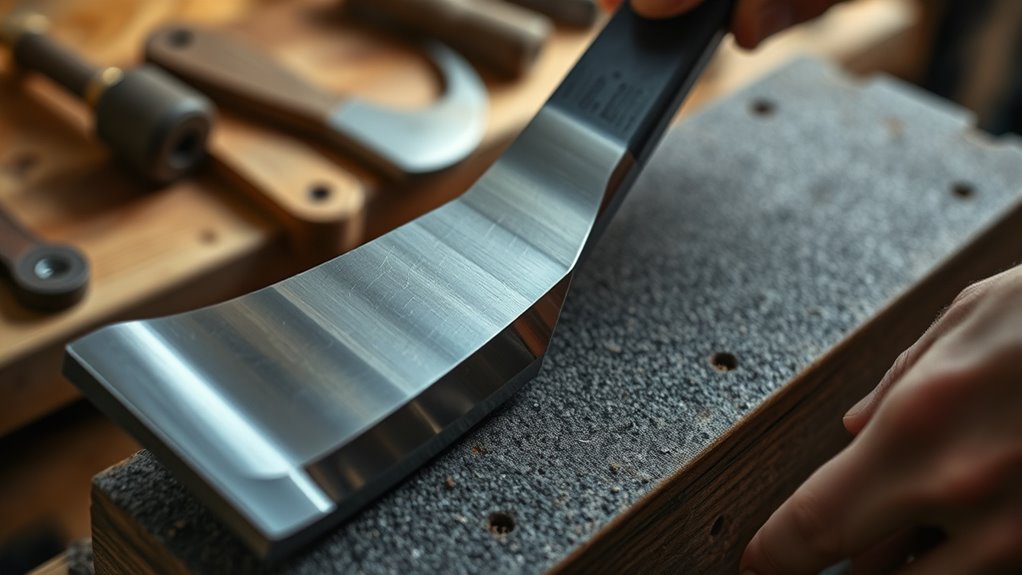To sharpen and maintain your axe, start by checking the blade’s angle, aiming for 25-30 degrees, and use sharpening stones or fine files to restore it, keeping the original geometry. Regular honing aligns the edge, reducing the need for heavy sharpening. Inspect the handle for damage and oil wooden handles periodically. Store your axe in a dry place with a protective cover to prevent rust. Keep up with these steps, and you’ll ensure your axe stays sharp and reliable for years to come.
Key Takeaways
- Use sharpening stones or fine files to restore the blade’s original geometry, maintaining a consistent 25-30 degree angle.
- Regularly hone the edge to keep it aligned and sharp, reducing the need for full sharpening.
- Inspect handles frequently for damage; repair or replace and oil wooden handles periodically for durability.
- Clean and dry the axe after use, storing it in a dry, protected place with a sheath to prevent rust and corrosion.
- Follow proper sharpening techniques, working slowly to preserve blade angle and avoid removing excessive material.

Keeping your axe in top condition is essential for safe and efficient chopping. A well-maintained axe not only makes your work easier but also extends its lifespan. To achieve this, paying attention to blade geometry and handle care is crucial. Blade geometry refers to the shape and angle of the cutting edge, which directly influences how effectively the axe cuts into wood. An optimal blade angle, usually between 25 and 30 degrees, balances sharpness and durability. If the angle is too steep, the edge becomes fragile and dulls quickly; too shallow, and the edge may chip or roll. When sharpening, focus on maintaining the original blade geometry. Use a sharpening stone or file to carefully re-establish that precise angle, working evenly across the edge. Regular honing keeps the edge aligned and sharp, reducing the need for aggressive sharpening. Ensuring proper technique during sharpening also helps preserve the blade’s integrity and performance.
Handle care is equally important. The handle absorbs most of the impact during chopping, so keeping it in good condition prevents accidents and ensures control. Check your handle frequently for cracks, splinters, or signs of wear. If you notice any damage, replace or repair the handle promptly. Wooden handles benefit from periodic oiling with linseed or mineral oil, which prevents drying and cracking. Avoid exposing the handle to excessive moisture or direct sunlight, as these can weaken the wood. For synthetic handles, ensure they’re securely attached and free from any deformities. Tighten loose fittings and replace worn parts to maintain a firm grip. Proper handle care also involves storing your axe properly; keep it in a dry place and avoid leaving it exposed to the elements. This prevents rust and corrosion of the blade, which can compromise cutting performance. Additionally, understanding the importance of blade protection can help extend your axe’s lifespan and performance.
When sharpening the blade, use the right tools—preferably a sharpening stone or a fine file—and follow the blade’s existing geometry. Maintain a consistent angle, and work slowly to avoid removing too much material. After sharpening, wipe the blade clean and apply a light coat of oil to prevent rust. Regular maintenance doesn’t stop at sharpening; inspecting the handle and keeping it conditioned is equally crucial. By paying attention to both blade geometry and handle care, you ensure your axe remains safe, sharp, and reliable for every task. Consistent upkeep saves you time and effort in the long run, making your chopping tasks smoother and safer. Remember, a well-maintained axe isn’t just about performance—it’s about your safety and the longevity of your tool.
Frequently Asked Questions
How Often Should I Sharpen My Axe for Optimal Performance?
You should sharpen your axe based on your usage and the condition of the blade, but a good rule of thumb is to do it regularly to guarantee peak performance. A consistent sharpening schedule, such as after every few uses or when you notice dullness, helps maintain your axe’s effectiveness. Proper axe maintenance involves not just sharpening but also keeping the blade clean and protected from rust, ensuring it stays sharp longer.
Can I Sharpen an Axe With Household Tools?
You can sharpen an axe with household tools, but it’s not ideal. For better results, use a sharpening stone, like a oil or water stone, and make sure your axe handle maintenance is up to date. First, clean the blade thoroughly. Then, hold the axe at the correct angle and carefully sharpen with the stone. Regular maintenance keeps your axe in top shape and extends its lifespan.
What Safety Precautions Are Essential When Sharpening Axes?
You’d think sharpening axes is a walk in the park, but safety’s no joke. Wear protective gear—gloves, goggles, maybe a helmet—and make certain your workspace is proper: clear, stable, and well-lit. Keep your hands away from the blade’s edge, and never rush. A sharp axe may cut wood, not your fingers. Stay alert, stay safe, and treat your tools like they’re about to bite back!
How Do I Prevent Rust and Corrosion on My Axe?
To prevent rust and corrosion on your axe, you should regularly clean and dry it after use, especially if it gets wet. Apply a thin coat of oil to the blade to protect it. Store your axe properly by keeping the handle dry and avoiding exposure to moisture, which helps prevent rust. Follow storage best practices by keeping it in a dry, enclosed space, and maintain the axe handle to ensure durability.
Is It Necessary to Balance an Axe After Sharpening?
Balancing your axe is important for safe and efficient use. After sharpening, you should check the axe weight distribution and handle alignment to make certain it’s properly balanced. An unbalanced axe can cause fatigue and reduce accuracy, so if the head feels heavy or the handle isn’t aligned, consider adjusting or replacing parts. Proper balance improves control, making your chopping safer and more effective without needing extensive rebalancing every time.
Conclusion
By regularly sharpening and maintaining your axe, you’re tending to a trusted partner on your outdoor journeys. Think of your axe as a mighty sword, its edge a gleaming blade ready to conquer any challenge. When you care for it, you’re not just preserving its sharpness—you’re fueling your own strength and confidence. Keep it honed and cared for, and it’ll serve you faithfully, cutting through obstacles like a well-aimed arrow soaring through the sky.









